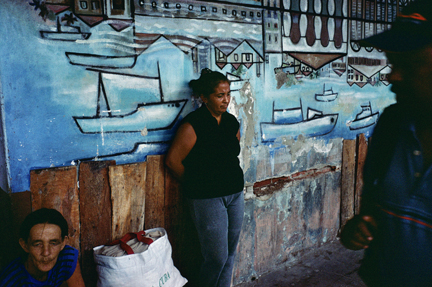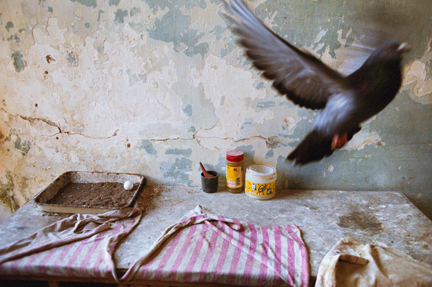Over the past few years, participants in Rebecca’s and my workshops have increasingly asked about the process of finding an author to write an introduction or afterword to a book of photographs. Every book is different: Some books call for silence –– little or no text; others seem to demand the (textual) voice of the photographer; and others seem to benefit from another, complementary voice. In many ways the latter is the trickiest: How will a given writer illuminate in words what is essentially a visual experience as well as expand on the viewer’s understanding of the subject of the book? In the case of Violet Isle, our upcoming book on Cuba, we had read a wonderful essay on Cuba by Pico Iyer in his book, Falling Off the Map. His notion of Cuba as the “ambiguous island” seemed to parallel our photographic sense of the enigma of Cuba. Rebecca and I were fortunate that he very kindly agreed to write an afterword to our book. Below is an excerpt, along with two photographs — one of mine, one of Rebecca’s — that Pico discusses in his essay. ––Alex Webb

Alex Webb, Cienfuegos, Cuba, 2007

Rebecca Norris Webb, Havana, Cuba, 2007
THE SUNLIGHT IN SHADOWS, THE STILLNESS IN MOTION
By Pico Iyer
As soon as I began paging through the wondrous images assembled here [in Violet Isle], on a winter morning in my two-room home in rural Japan, I felt that the movement and the stillness that lie at the heart of Cuba –– and its neverending conundrums –– were assembled in this book with a tension and vitality I’d never seen before. Alex’s work startles and shocks, as always, with the complexity and crowdedness of its frames, perfect match to a country where everyone is always around you, though not doing very much at all. You feel the laughter on those faces, and also the torpor, the long hours passed in waiting for the next drama to pass through town. The energy in the frames works oddly against the sense of suspended motion, so that you begin to sense the ordered chaos that somehow helps Cuba tick along.
A fence shapes our vision of constant motion. A bright-eyed boy sits in front of the veiled gaze of an elder. “Violent” is just “violet” shifted around a little. There are even animals along his busy streets.
And Rebecca’s work rhymes with his partly because her interiors are equally evocative, and their stillness takes us into a realm of longing and tenacity. The beady eye of a thing with feathers catches me, as I note the tightness of its taloned grip; a fluffy, seemingly lovable dog puts its paw on a wonky machine. The shining colors in a feather, humble and sometimes elide into the shadows and the backdrops all around.
It is as if she catches the melancholy interiors, and all the quirky secrets kept there, one reason, perhaps, why the island still survives, in spite of everything. In many of her images I see the beauty that’s always hiding out in Cuba––on rooftops, in backyards, in the dusty corner of an unlit room. People show you their treasures, and some of them break your heart because they’re so shoddy and worn and speak for such privation. Some of them break your heart because they show you what these magnificent and resourceful people could do if only they were given a chance.
In all her work here, though, you feel the tight quarters in which Cubans live—and their longing for flight. Life and confinement flap against each other in her images. On the one hand, Cuba seems to be a kind of taxidermist’s island where life has been artificially preserved, or ossified; on the other, you have only to look at her reptiles and chickens to feel the life there. Even in the graveyard, the dogs seem to be breathing.
So image dances with image in their duet, and Alex’s picture of a woman (of what age?) against a wall with drawings of boats heading off to other places echoes Rebecca’s images of birds taking off, to claim a freedom that their owners lack. The spilling abundance of Cuba’s street life (in Alex’s work) opens out onto the hushed richness of its homes (in Rebecca’s). The result is the shadow world that I recall, which leaves you never knowing how much to laugh and how much to grieve.
In Alex’s work, urgent, immediate and full of information, I always feel a sense of mystery, and all that lies beyond the frame, unspoken. In Rebecca’s, animals and surfaces look back at you with such direct clarity that they become equally perplexing, unfathomable. The book you hold in your hand is as alive and shifting and contrapuntal a portrait of the violet island as any I have seen. It catches the raised finger as well as the stopped clock, the life and uproar as well as the long spaces between. You say you’ve never been to the island of seductive surfaces and the depths they contain or try to push down? You have now, I think, if you’ve lived for a while with the work of these far-seeing—and perfectly complementary––artists.
The above excerpt is from Pico Iyer’s afterword to Violet Isle: A Duet of Photographs from Cuba (photographs by Alex Webb and Rebecca Norris Webb; text by Pico Iyer) published by Radius Books, November 2009, reprinted by permission of Pico Iyer and the publisher.
Pico Iyer is one of the most revered and respected travel writers alive today. His essays, reviews and other writings have appeared in Time, The New York Review of Books, The New Yorker, Harper’s and Conde Naste Traveler. His books include Falling Off the Map, Cuba and the Night, and The Open Road.






